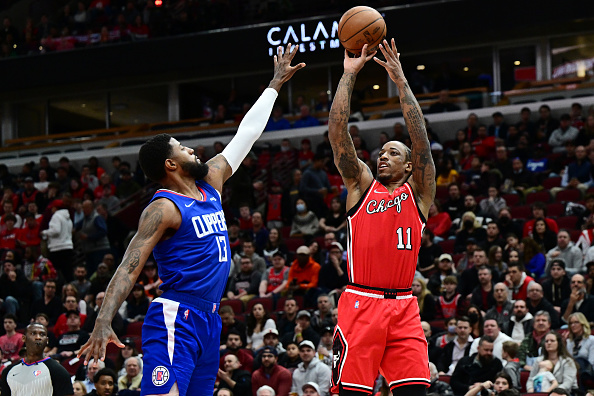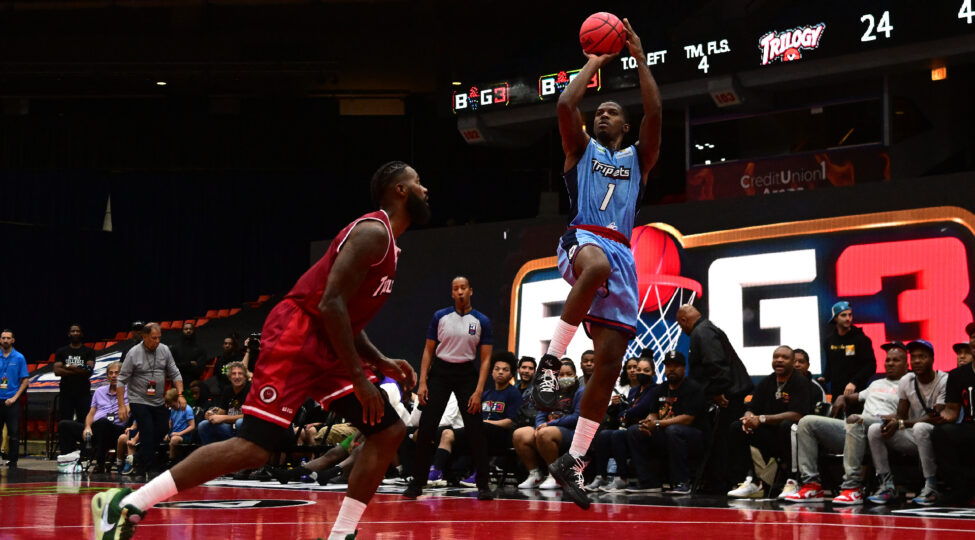The mid-range game is beautiful. Think of MJ’s unstoppable array of pull-ups and fadeaways, the way Kobe set up his gigantic arsenal of midrange shots with footwork best described as balletic, Dirk’s iconic one-footed fadeaway from the midpost, Carmelo Anthony facing his man up and breaking him down with his signature series of jab-steps before dropping an 18 footer over his head, Rip Hamilton flying off down-screens to get a look from midrange, that little pull-up from the right elbow Chris Paul has been knocking down for nearly two decades – the list goes on.
It’s also true that the midrange game is, for a number of good reasons, not-so-slowly being phased out of the modern NBA. There are some holdouts like Demar DeRozan, but NBA players whose games are based around the mid-range shot are few and far between.

Meanwhile, there are a number of equally good reasons why the midrange game in FIREBALL3 remains alive and well. Let’s break it down:
1 – A Brief Summary of the Factors that led to the NBA’s “3-point revolution.”
First off, the NBA made major rule changes after the 2003-04 season. The “illegal defense” rule was taken away, and teams were allowed to play zone defense. Before this rule change, a defender had to be distinctively guarding his man or committed to a double-team, or a technical foul would be called.
With zone defense in place, teams were free to allocate their defensive resources to the most dangerous players on the floor, particularly in the post, where help-side defenders could essentially pre-set up a double team on a big man instead of being forced to wait for him to catch the ball before the rules allowed them to double. Along with the crackdown on hand-checking, the NBA became a league where offenses attacked from the inside-out to one where they attacked from the outside-in.
Second, a wave of players and coaches came into the league who had grown up with the three-point shot as a fact of life. The NBA didn’t get a three-point line until the 1979-80 season. Up to that point, there had been no incentive to take a 23-foot shot instead of an 18-footer, and no coach in the league had anything in their playbook that accounted for long-distance shots suddenly being worth an extra point.
So players and coaches stuck to what they knew, and for a long time the three-point line was considered more of a gimmick than a part of a successful offensive strategy. It wasn’t until players who had grown up shooting threes, and, just as importantly, were taught the game by coaches that understood the power of the three-point shot, that it really started to get incorporated into every offense.
In the 1985-86 season, Larry Bird led the NBA with 82 made three-point shots. Last season, 141 NBA players made 83 or more shots from beyond the arc.
The third factor behind the three-point revolution was analytics. “Analytics” can be a contentious topic among basketball coaches, players, and fans, so for right now we’re going to forget anything that resembles a formula and define analytics as “things being counted that weren’t being counted before.” In today’s NBA, everything is tracked.
What we’re interested in is the tracking of field goal percentage on mid-range shots, which happened starting around the early 2000s. (Since then, hardworking folks have gone back and watched enough tape so that we have this data going back to the 1996-97 season). Learning just how often mid-range shots went in was fascinating and ultimately game-changing.
Almost nobody, and I mean almost literally nobody, makes more than 50% of the midrange shots they take. Some players, including the ones I mentioned above, have seasons where they make just over 50% from either 10-15 feet or 16-23 feet, but in my experience, it’s pretty much been impossible to find someone who consistently shoots over 50% on mid-range jump shots.
If you do the very simple math (if it was difficult, I wouldn’t be able to do it, trust me), making 50% of your two-point shots is equivalent to making 33% of your three-point shots. (E.G. – going 6-12 from 2 will yield 12 points, as will going 4-12 from beyond the arc.) Unlike shooting 50% on two-point jumpers, shooting 33% from three-point range is not that hard to do. 123 NBA players shot 33% or better from deep last season, and 25 shot better than 40% – the equivalent of the latter would be shooting 60% on two-point jumpers, which would be absolutely unheard of.
Before we had this data, the only way to “see” where a player was taking a shot was by looking at the box score, which treats a wide-open layup the same as a turnaround fadeaway with your foot on the three-point line the same. It’s only the three-point shots that get singled out on the box score. When a player would shoot 1-9 from three-point range, the cries for him to take it inside would be deafening. When that same player shoots 1-9 on 20-footers, only the most eagle-eyed viewers would get angry over it – according to the box score, he was just trying to get inside as much as possible.
So now we get into the final factor, which is now that the long-term efficiency of the three-point shot has been made clear, every player puts it into their arsenal, up to and including players like Joel Embiid. Also, there have been three-point pioneers. Reggie Miller showed that you can build an offense around a rail-thin swingman running around screens behind the arc. Dirk Nowitzki showed the value of a big man who can hit the three. Steph Curry showed that if you really are that good, nothing inside the half-court line is really a bad shot. James Harden showed you can convert a fair amount of threes straight out of isolation situations, and so on and so forth.
Thanks to all of that, the mid-range game is being phased out in favor of the three-point game – it’s all about layups, free throws, and three-pointers now, as they’re the most efficient shots on the floor. Again, this is a good strategy, but it’s understandable to pine for players who were true midrange masters. Teams constantly try to get to the basket for a layup or foul, and if they can’t do that they kick it out for a three. That’s just the way of things in the NBA now.
2 – How FIREBALL3 is Keeping the Mid-Range Shot Alive
In basketball, the offense has one major advantage and the defense has one major advantage. The offense has the ball, and thus what I call “initiative” – they get to decide what they’re going to do, how they’re going to move, who they’re going to pass to, and when they’re going to shoot, and the defense is forced to react to that.
Meanwhile, the defense has an extra defender – the shot clock. Without a shot clock, there would be no reason for an offense to take a shot that was anything less than perfect – they’d just move the ball, look for a layup or open three, and start the process over again if they didn’t find one for as long as it takes. Basketball with no shot clock can even lead to crimes against the game like the “four corners” tactic. (Oddly, before the shot clock was introduced in the NBA, teams played much faster and less efficiently than they would in later generations – the history of basketball is weird.)
So, to keep it simple, the less time an offense has to operate, the less time it has to set up an analytically “ideal” shot – a free throw, layup, or a good look at a three-pointer. That means that in the BIG3, where the shot clock is just 14 seconds long, players will often have to “settle” for the shot any professional ballplayer worth his salt can get at any time – the mid-range jumper.
Joe Johnson, the greatest player in BIG3 history, always has his deadly turnaround fadeaway from the mid-post in his back pocket, which is a big part of how he won the scoring title (and MVP) in his first two seasons with the BIG3. Iso-Joe and his signature fadeaway have also started off the 2022 campaign with two 30-point games in the first three weeks of the season.
Death. Taxes. Joe Johnson Game-Winners. @TheJoeJohnson7 | @big3triplets pic.twitter.com/tjc7kfh4pI
— BIG3 (@thebig3) June 25, 2022
Also, the three-pointer is generally set up by some sort of foray to the rim. When a lightning-quick player gets to the rack in other leagues, he’s generally able to convert a dunk or layup, draw a foul, or kick it out to an open three-point shooter whose defender collapsed on the man in the lane. The worst-case scenario is that they fail to convert, in which case the opposing team has to go 94 feet to get a bucket.
FIREBALL3 discourages this in a number of ways. First of all, the league prides itself on being more physical than other pro leagues, meaning a player who gets shut down inside has less of a chance of getting bailed out by a whistle. Second, if a player turns it over near the basket, gets his shot blocked, or gets forced into taking a wild shot that fails to draw iron, the punishment is punitive. Instead of needing to run a 94-foot fast break, as often as not the opposing player who catches the ball can go right back up and drop in a layup for their easiest basket of the game.
That brings us to another point regarding the fast break. Many open 3-point looks come in transition. The offense gets the rebound or turnover and gets a man advantage from pushing the ball. The defense uses the men it has to protect the rim. This leaves an open three-point shooter, as a modern fast break typically consists of the ballhandler, the man filling the lane. Finally, with more and more big men having the three-point shot in their arsenal, open threes often come from giving the ball to the “trail man” spotting up from deep on the break.
These opportunities obviously aren’t available in FIREBALL3, which is played entirely in the half-court. (One note: Gerald Green currently leads the league in three-pointers made. One of his signature moves is to sprint to the short corner in an attempt to find an open look at a three when he or a teammate grabs a defensive rebound. That’s as close to a “transition” three-point opportunity as you’ll find in FIREBALL3.)
Because of all of the above, FIREBALL3 provides fans with a chance to see less of the increasingly clinical approach to offense we see in other leagues, and instead incentivizes players to show off what they have in those wonderful bags of theirs as they try and set up a nice look from mid-range.



